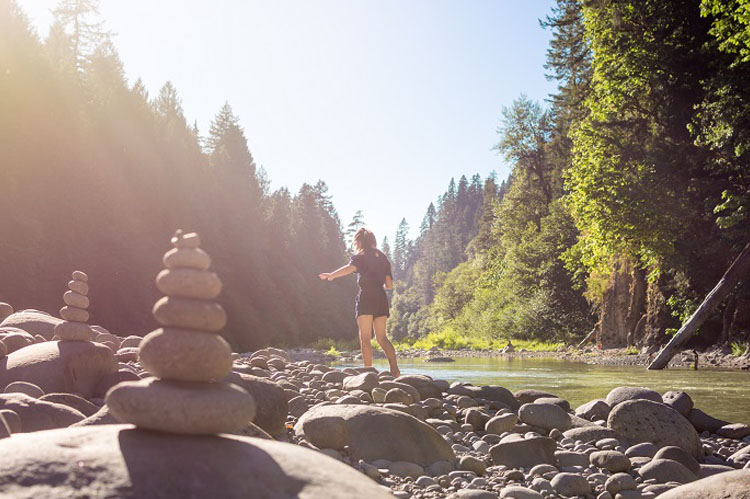When it comes to stone stacks, or “cairns” as they are historically called, hikers can get caught between a rock and a hard place. Build them or trust them at your own peril.
The word cairn originated in Gaelic, meaning “mound of stones.” Their primary purpose for the Celts, Native Americans, and other bygone cultures was to mark graves and sacred spaces. You can find an example in Missouri at Painted Rock Conservation Area in Osage County, where inhabitants placed a mound of broad, flat stones nearly 9,000 years ago on the scenic bluffs overlooking the Osage River.
Today, though, cairns commonly mark hiking trails in areas where tacking up a sign or digging a post hole is impractical, such as rocky or gladed areas. “They serve a dual purpose,” said Dan Zarlenga, the Missouri Department of Conservation’s media specialist for the St. Louis region. “They keep people from getting lost, and they concentrate humans’ environmental impact in one spot, rather than spread it out over a sensitive area.”
But when it comes to signage, not all trails are created equal, according to Johnathan Rhodes, wilderness trail manager in Mark Twain National Forest. Trails through sections of the forest designated as recreation area tend to be better marked by official cairns than the seven designated wilderness areas in Missouri.
“We’re trying to maintain the solitude, so everyone gets the same experience,” Rhodes said. “We have so little of that kind of country to explore.” So, in areas such as Hercules Glade Wilderness Area near Ava, he is more likely to dismantle than construct a cairn.
Talk about a delicate balance. Susie Stevenson, REI St. Louis’ outdoor programs and outreach market coordinator, trusted cairns to keep her on course while hiking the open terrain between Mount Bierstadt and Mount Evans on the Front Range in Colorado. She acknowledged that if someone had moved or removed one of those rock piles, she would have been in trouble.
“Since cairns are navigational tools, building them willy-nilly all over the place is just rude,” Stevenson said.
As a matter of etiquette, rangers, managers, and many hikers invoke principles of Leave No Trace in the preservation of cairns, specifically:
- Travel on durable surfaces. Cairns placed by trail officials are intended to keep people away from animal habitat and minimize environmental impact.
- Leave what you find. Leave cairns in place. Don’t add or subtract.
- Respect wildlife. Some of those rocks, especially the low, flat ones favored for cairns, provide shelter for the critters. How would you like it if somebody moved your house?
To some people, though, Leave No Trace sounds like that grumpy old man down the block, yelling at the neighborhood kids to stay off his lawn — which leaves them just itching to toilet paper his house. Even certain outdoor lovers turn a blind eye to Leave No Trace when it comes to cairns, seeing them as an invitation to add or subtract a rock without toppling the stack.

Rock cairn on the Taum Sauk section of the Ozark Trail.
And therein lies the potential for confusion, even for people who should know better. Just ask Jim Davis, a former board member of the Ozark Trail Association. He led a hike up Black Mountain, following cairns that he thought were placed by the trail managers. They were instead of the willy-nilly variety, “and we ended up lost most of the day,” Davis said. “The cairns led to a pile of rocks. Then, next thing you know, it’s almost dark. We were lucky we ended up going in a circle. Even being proficient in the outdoors didn’t help.”
Zarlenga said local incidents of moving or removing cairns have been minor and isolated, though a few self-expressionists have lined the banks of the Buffalo, Jacks Fork, and Current rivers with their handiwork in southern Missouri and Arkansas. Removing, replacing, and adding cairns have caused a bigger stir in national parks, notably Zion, Hawaii Volcanoes, and Acadia.
But holding hikers accountable is messy business. Given forest fires and other large-scale threats to these vast expanses of wilderness, cracking the whip on unauthorized rock stackers remains a relatively low priority with the National Park Service or Department of Natural Resources.
So, we circle back to the honor system implicit in Leave No Trace and trusting your fellow hikers. But that doesn’t mean you shouldn’t hedge your bets. Rhodes advises registering at the trailhead and bringing along GPS and a trail app. Davis also advocates a compass and “good, old paper maps. Electronics can fail, so going old-school is a great fallback,” he said.
Author: Kathleen Nelson is a regular contributor to Terrain Magazine.


Leave A Comment